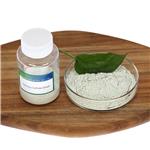Iron(II) sulfate hydrate, also known as ferrous sulfate hydrate, is Off-white to beige powder. Astringent odor. Mainly composed of FeSO4.H2O and contains a small amount of FeSO4.4H2O. harder to oxidize, and easier to store than crystalline ferrous sulfate. The aqueous solution is acidic and turbid, gradually producing a yellow-brown precipitate. It absorbs water into heptahydrate in humid air. Heating to 120 ℃ does not lose water. Boiling with water can be converted into alkali sulfate. Slowly soluble in cold water (26.6g/100ml, 20℃), rapidly dissolved when heated. Insoluble in ethanol. Almost insoluble in 50% sulfuric acid.
Iron(II) sulfate hydrate has been used to prepare ferrous ion solution to study the influence of iron ions on the thermal decomposition behaviour of hydroxylamine/water solutions.
ChEBI: Iron(2+) sulfate monohydrate is a hydrate that is the monohydrate form of iron(2+) sulfate. It is obtained from the heptahydrate by heating above 65℃. It is used as a source of iron in the treatment of iron-deficiency anaemia (generally in solid-dosage treatments; for liquid-dosage treatments, the heptahydrate is normally used). It has a role as a nutraceutical, an anti-anaemic agent and a reducing agent. It is a hydrate and an iron molecular entity. It contains an iron(2+) sulfate (anhydrous).
It is obtained by drying crystallized ferrous sulfate into powder at 40℃. Heating to 45 ~ 50 ℃ when dissolved in the water of crystallization and liquefaction, while stirring and slowly evaporating the water of crystallization. The limit of dry weight loss is 35%~36%, generating a small particle state fine powder, made of powder, sealed and stored.
Ferrous sulphate heptahydrate (FeSO4.7H2O), also known as green vitriol or copperas, contains 19% iron and is a common iron fertilizer. It is the best known ferrous salt.



